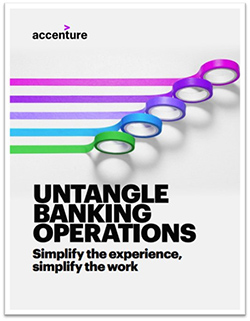Other parts of this series:
Guest bloggers Ben Lopez and Charlie Arthy examine the evolving role of the COO in post three of their series on achieving simplified, future-ready bank operations.
The focus for bank COOs is expanding beyond a pure cost perspective to include customer experience. Our recent banking survey showed that 74 percent of bank operations executives named customer experience as one of the top three priorities.¹ In sync with this new top priority and the reality that technology drives highly efficient, straight-through processing, the role of the bank COO is shifting.

The shift is really blurring the lines between the COO and the CIO, even to the point of a bank having a hybrid COO-CIO role, where the executive running operations also runs technology with an eye on how the bank’s internal apps play externally. While the CIO ultimately will always “own” the underlying technology and ensure a cohesive ecosystem, the COO needs to drive the decisions to modernize operations and help choose the best-fit, most relevant technologies that enable the bank’s goals.
One such aim is revenue growth. As the back office becomes “the front office” helping to drive top-line revenue growth, the COO will be increasingly called upon to make strategic contributions to the bank’s growth strategy. For example, COOs can collaborate with CIOs to unlock key customer insights from data stored in operational systems, treating data as a differentiated asset and creating a more relevant customer experience. The COO is also in the position to lead various digital transformation (and analytical) programs that open up new revenue streams from customer data. Other bank organizational models have one person responsible for both the COO and the CTO roles (often including oversight of the work of chief digital officers in making the bank digital), given the size and importance of change occurring in the back office.
It is imperative that a bank significantly evolves the role of the COO, if it is to be successful in an environment where new, tech-focused entrants are taking considerable bites out of traditional banks’ value chains.
The new bank COO, who will now champion and govern the value that must be fully exploited, should look to take three key actions:
- Identify visionary capabilities that enable strategic operating models and customer experiences previously unseen in banking. Most often, doing so will require banks to place greater focus on enabling technologies, the entire digital ecosystem and Open-Banking-driven partnerships with other adjacencies in the value chain in ways that grow bank revenues.
- Deliver on the vision by building out iterative changes through micro-services or other component and API-based architectures that allow for rapid integration with best-in-market solution providers.
- Adopt new delivery techniques (such as Agile) that enable rapid change and the ability to adapt quickly to customer needs.
Learn more about the evolving role of the COO from our report, Untangle Banking Operations: Simplify the Experience, Simplify the Work.
In our next blog, we will discuss the importance of an agile workforce in creating simplified, future-ready banking operations.











